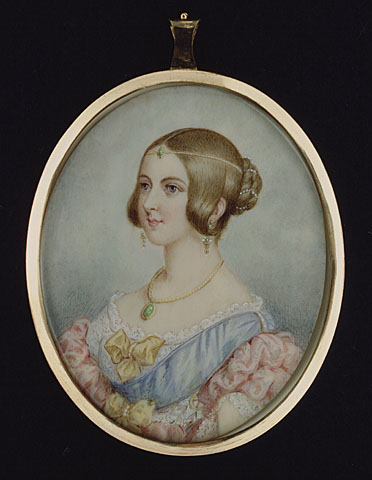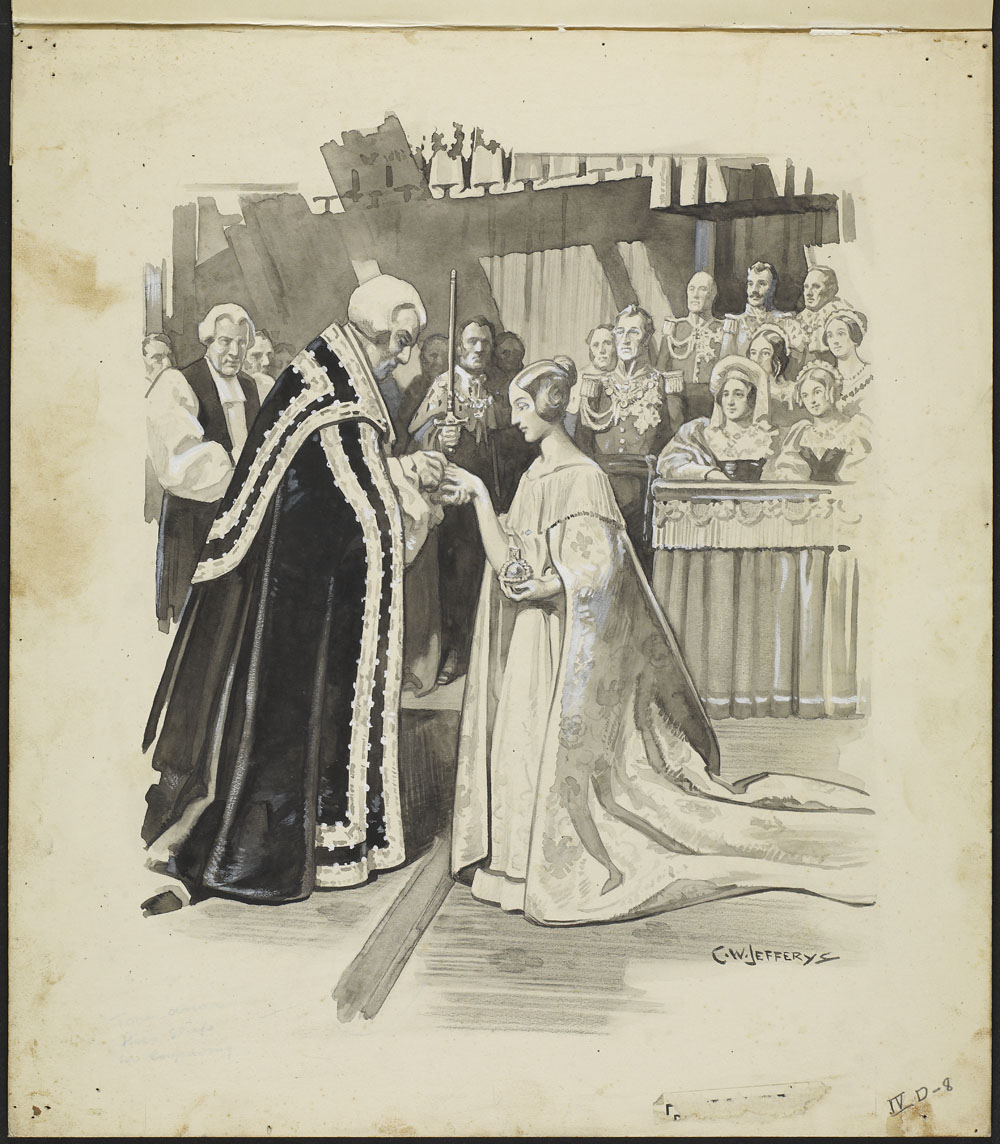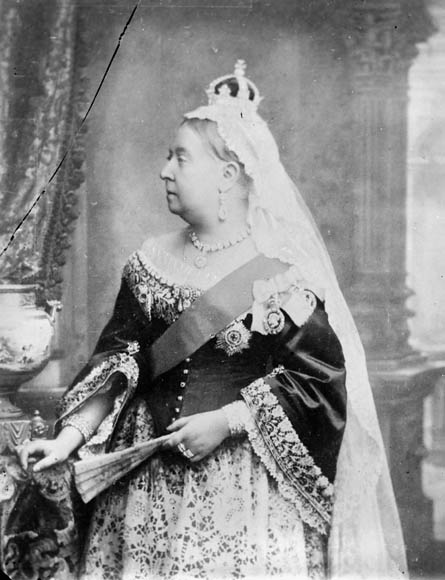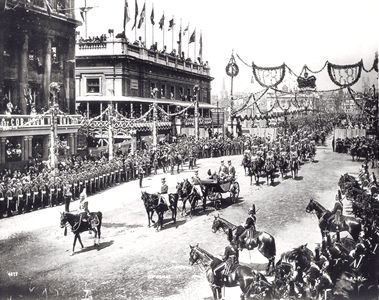What Did Queen Victoria Do to Make the Economy Better
Victoria, queen of the Uk of Swell Britain and Ireland and Empress of India (born 24 May 1819 at Kensington Palace, London; died 22 January 1901 at Osborne House, Isle of Wight).
Victoria, queen of the United Kingdom of Groovy Britain and Ireland and Empress of India (born 24 May 1819 at Kensington Palace, London; died 22 Jan 1901 at Osborne Firm, Island of Wight).

Queen Victoria succeeded to the throne at historic period 18, following the death of her uncle, William IV, in 1837. She was an agog imperialist and took an intense involvement in her colonial subjects. Queen Victoria favoured Confederation and acted as a unifying influence for Canada'southward provinces. While the Queen never visited Canada, five of her 9 children spent time in Canada, where her proper noun has been given to numerous public buildings, streets, communities and physical features.
Parents
The future Queen Victoria was the only kid of Prince Edward, Duke of Kent and Strathearn (1767–1820), the fourth son of King George III, and Princess Victoire of Saxe-Coburg-Saalfeld (1786–1861). Edward was the beginning fellow member of the imperial family unit to reside in Canada for a sustained menstruum of time. He spent the 1790s in Québec City and Halifax, where he helped improve British Due north American defences and became commander-in-chief of the British Due north American forces. Prince Edward Isle is named for him. Later on the death of his niece, Princess Charlotte, in 1817, Edward married at the historic period of 50. His marriage was necessary in guild to continue the line of royal heirs after Charlotte's passing. Victoire was 20 years younger than Edward and the widow of Prince Charles of Leiningen. She had ii children, Charles and Feodora, from her get-go marriage.
Early Life
On 24 June 1819, Victoria was christened Alexandrina Victoria in honour of her godfather, Czar Alexander I of Russia, and her mother. Her father died of pneumonia earlier her showtime altogether, and she grew up at Kensington Palace in London under the guardianship of her mother. Victoire disapproved of Edward's brothers, who were derided for their gambling and mistresses; and the young Victoria saw little of the majestic family. She was, for example, non permitted to nourish the coronation of her uncle and predecessor, William IV, in 1830. Victoria was educated at home and grew upwards to be stubborn and strong willed.
Accession to the Throne
Victoria became queen upon the death of William IV on 20 June 1837. There was an outpouring of popular enthusiasm virtually the 18-year-old monarch, whose respectability contrasted with her uncles George 4 and William IV. After attending her coronation at Westminster Abbey on 28 June 1838, diarist Sir Charles Greville wrote, "It is, in fact, the remarkable union of naïveté, kindness, nature, skilful-nature, with propriety and nobility, which makes her and then beauteous and so endearing to those about her." After the seclusion of her childhood, Victoria enjoyed her new position and was an enthusiastic participant in court balls and other entertainments.
Victoria came to the throne only months before the Rebellions of 1837–38 were mounted in Upper and Lower Canada. On 22 Dec 1837, the Queen wrote in her journal, "The news are, I grieve to say, very bad from Canada; that is to say rumours and reports by the Papers, though we take no Official Reports. Only [Prime Minister] Lord Melbourne hopes it may not exist then bad equally information technology is rumoured. There certainly is open Rebellion." In honour of her coronation, the Queen granted amnesties to the rebels in Upper and Lower Canada (see Amnesty Human activity).
Union
On fifteen October 1839, Queen Victoria proposed to her cousin, Prince Albert of Saxe-Coburg-Gotha. They were married at St. James's Palace on 10 February 1840. Victoria wore a white satin and lace dress, starting the fashion for white wedding dresses that continues to the present. Victoria was deeply in honey with her married man, writing in her journal at the time of her wedding: "His beauty, his sugariness & gentleness — really how can I ever exist thankful enough to have such a Hubby!"
During the showtime years of her marriage, Victoria prevented Albert from becoming involved in her duties every bit sovereign, a stance that Albert resented. As their marriage progressed, Victoria became increasingly dependent on Albert, and he came to exert political and cultural influence. He advised Victoria on state documents, drafted her correspondence and reformed imperial finances. Albert chaired the Slap-up Exhibition, which showcased British and international merchandise at London's Crystal Palace in 1851 and inspired similar displays around the globe. He received the title of prince consort in 1857, though Sir Charles Greville remarked, "He is Rex to all intents and purposes."
Children
Queen Victoria had 9 children: Victoria (1840–1901), Albert Edward, the futurity Edward 7 (1841–1910), Alice (1843–1878), Alfred (1844–1900), Helena (1846–1923), Louise (1848–1939), Arthur (1850–1942), Leopold (1853–1884) and Beatrice (1857–1944). Prince Albert was present in the delivery room for the births with government ministers and clergymen assembled in the bordering room. Albert was likely the get-go royal male parent to be present for the births of his children. Current purple christening traditions, such equally the use of the lily font and Honiton lace robe, date from the christenings of Victoria'due south children.
Victoria popularized childbirth anaesthesia, then a controversial medical intervention, when she requested chloroform for the births of Leopold and Beatrice. She had fiddling interest in young children — writing that "an ugly baby is a very nasty object — and the prettiest is frightful when undressed" — and Albert assumed a more than active role in the children's education and upbringing. Victoria became closer to her children as they aged. The royal family's public image conformed to 19th-century ethics of domesticity in the English-speaking world. Images of Victoria, Albert and their children jubilant Christmas and taking family vacations influenced broader parenting trends.
All four of Victoria'due south sons spent time in Canada. Edward Vii, the hereafter king, undertook a highly successful tour of British North America and the U.s.a. in 1860 that set precedents for future purple tours, including date with Canadians from a variety of communities and backgrounds, and showcasing local culture. Alfred spent five weeks in the Maritimes in 1861; and Arthur spent a year with the Rifle Brigade based in Montréal in 1869–70. As Knuckles of Connaught, Arthur would return to Canada as Governor Full general from 1911 to 1916. Victoria's daughter, Louise, was vice-purple consort from 1878 to 1883, when her husband, the Marquess of Lorne, became the 4th Governor General since Confederation. Leopold visited Louise in Ottawa and they visited Niagara Falls together. Louise and Lorne founded the National Gallery of Canada (1880), the Royal Canadian University of Arts (1880) and the Royal Gild of Canada (1882) during their time in Canada.
Widowhood

Prince Albert died at Windsor Castle on 14 Dec 1861 from either typhoid fever or Crohn's Illness. Victoria was devastated and began a long catamenia of seclusion during which she refused to undertake most public duties. While the public was initially sympathetic, Victoria's unwillingness to either resume regular public appearances or delegate responsibilities to her eldest son attracted criticism and increasing republican sentiment. Victoria'southward popularity in Great britain was restored in 1872 when she agreed to a public thanksgiving service at St. Paul's Cathedral subsequently the future Edward VII recovered from a well-nigh-fatal attack of typhoid. In Canada, a day of thanksgiving was celebrated in honour of the heir to the throne's recovery. Victoria's popularity remained constant in Canada during her widowhood, as she had never visited in person and therefore Canadians did not feel a directly change in her public appearances. Victoria was a widow for 40 years and her all-time-known public image as "the widow of Windsor," in which she appeared in uncomplicated black dresses and white bonnets, is one that endures.
Political Influence
Equally a constitutional monarch, Queen Victoria was expected to be higher up politics, but she nevertheless expressed her partiality for particular British prime ministers. During the early years of her reign, William Lamb, 2nd Viscount Melbourne, acted equally a father effigy and mentor to Victoria. Later in her reign, she favoured Prime number Government minister Benjamin Disraeli — who provided her with entertaining political anecdotes — over the more than reserved Prime Minister William Ewart Gladstone, whom she complained, "addresses me as though I were a public meeting."
Victoria's political opinions and priorities shifted afterwards Albert's decease. During her xx-year marriage to Albert, she shared his delivery to such domestic reforms as reducing tariffs and raising the minimum working age to reduce child labour. Over the course of her widowhood, she became an enthusiastic imperialist and emphasized her role as "mother" of the British Empire.
Canada's Confederation
It is fitting that Province of Canada delegates sailed to the 1864 Charlottetown Conference in Prince Edward Island aboard the Queen Victoria steamship. At the conference, Canadian delegates took the opportunity to propose British North American union to the Atlantic colonies. Victoria played a supportive role in the development of the Dominion of Canada, bringing together political figures from the British N American colonies through their shared loyalty to the Crown. She was broadly known as the "Mother of Confederation," who believed that Confederation would reduce defense force costs and strengthen relations with the U.s.. "I take the deepest involvement in information technology," Victoria told a Nova Scotian delegation in London, "for I believe it will make [the provinces] great and prosperous." In 1857, Victoria selected Ottawa — then an obscure lumber town called Bytown — as the Province of Canada's capital. She chose Ottawa again as upper-case letter for the Dominion in 1867 as information technology was sheltered from potential American invasions and stood on the border betwixt English and French Canada.
Victoria met with John A. Macdonald and four Canadian delegates in February 1867 every bit the British North America Human action was passed before British Parliament. Macdonald recalled that Victoria said, "I am very glad to see you lot on this mission. […] Information technology is a very important measure and yous have all exhibited so much loyalty." Macdonald invited Victoria to open Canada'due south kickoff session of Parliament in Ottawa on ane July, but she was unable to nourish.
Mother of the British Empire
It is estimated that one-5th of the world'south land mass became part of the British Empire and Dominions during Victoria's reign — supporting the axiom that the sun never prepare on the British Empire. During the last decades of her reign, Victoria'southward function as "mother" to the British Empire became a key office of her image. She became Empress of India at the suggestion of Disraeli in 1877.
Although Victoria did not personally travel beyond Europe, she emphasized her personal human relationship with Indigenous peoples around the world. In Canada, treaties were ended between Beginning Nations and the Crown as the "Great Mother." As Canada expanded westward, and so did Victoria's empire. Royal visits by Victoria'due south children to Canada'south west were an opportunity to affirm Victoria'due south personal relationship with her subjects. Victoria's son-in-police, Lord Lorne, was greeted as the "great brother-in-law" by First Nations communities when he travelled across the Prairies in 1881.
Canadian writer Charles Dent wrote in 1880, "In Canada, loyalty has by no means degenerated into a mere feeble sentiment of expediency. Throughout the length and breadth of our country the proper noun of Queen Victoria is regarded with an affectionate love and veneration which is felt for no other man."
Grandmother of Europe
Victoria's children and grandchildren married into Europe's royal houses, which resulted in the monarchies of Europe being closely interrelated by the outbreak of the Kickoff World War in 1914. Her granddaughters included five royal consorts: Empress Alexandra of Russia, Queen Marie of Romania, Queen Maud of Kingdom of norway, Queen Sophie of Greece and Queen Victoria Eugenia of Spain. Her eldest grandchild was Kaiser Wilhelm II of Federal republic of germany. The marriages of Victoria's descendants spread British cultural practices and political influence across Europe. Victoria's youngest son, Leopold, suffered from hemophilia, an inherited blood disorder passed to males through the female person line. Hemophilia became known as the "royal affliction" every bit it spread through Victoria'due south descendants to the German, Spanish and Russian ruling houses.
Jubilees
Victoria was the first British monarch to celebrate public Gilded and Diamond Jubilees, which marked the 50th and 60th anniversaries of her accretion to the throne. These jubilees were celebrated throughout the British Empire including thanksgiving holidays in Canada. The 1887 Gold Jubilee showcased Victoria's role as "grandmother" of Europe and the guests included royalty from beyond the continent. The prime ministers of the 10 self-governing overseas provinces in addition to Canada gathered in London for the Golden Jubilee to hold what was, in upshot, the commencement Commonwealth Conference, a forerunner of the modern day Commonwealth Heads of Regime meetings.
The 1897 Diamond Jubilee emphasized Victoria'southward part as caput of the British Empire and Dominions. The Canadian cavalry rode v abreast at the Head of the Colonial Procession. Prime Government minister Sir Wilfrid Laurier, who had received his knighthood from the Queen that morning, followed in a carriage. The Toronto Grenadiers and Royal Canadian Highlanders were likewise office of the parade. Victoria's personal message to Canada on the occasion of her Diamond Jubilee was "From my center I thank my dear people. May God bless them." Canada's gift to Victoria in award of her Diamond Jubilee was the establishment of the Victorian Order of Nurses. The Diamond Jubilee also had a profound upshot on Canadian pop culture as new songs were composed in the Queen's award and buildings named for her.
Last Years
Victoria was United kingdom of great britain and northern ireland'south longest reigning monarch at the fourth dimension of her expiry in 1901, a record that Queen Elizabeth Two surpassed on 9 September 2015. Victoria remained actively engaged with the British Empire until her terminal days, closely following the Due south African War. She died at Osborne House on the Island of Wight surrounded past family unit. Her death was regarded as the finish of an era. The Canadian authorities decided that Victoria Day, which had been celebrated as the Queen'due south altogether in Canada since 1845, would exist a permanent statutory holiday to honour her office equally a "Mother of Confederation."
Canadian Sites Named for Queen Victoria
Many of Canada's towns and cities, public buildings and institutions, parks and plazas, streets and concrete features have been named for Queen Victoria — and under dissimilar iterations of her title: Queen, Empress, Victoria, Regina. Explorers, mapmakers and administrators assigned the name Victoria to a multitude of geographical features all over the Canadian map. Perhaps no individual has been more honoured in this way in Canada.
Victoria Higher (now part of the University of Toronto) and Queen's University in Kingston, Ontario, were named for the Queen during her reign, every bit was the Royal Victoria Hospital in Montréal. The Victoria General Hospital (congenital 1911) in Winnipeg was also named for her.
The best-known identify named for the British monarch is the city at the base of Vancouver Island. In 1843, the Hudson's Bay Company (HBC) resolved to name its new fort overlooking the Juan de Fuca Strait for the Queen, though Fort Albert was the name information technology was assigned locally. Afterwards, a stern message from London insisted on the use of Fort Victoria. The town site of Victoria was established there in 1851–52; and in 1868, the expanding city became the capital of the colony of British Columbia (itself named by Queen Victoria).
The province of Alberta also had a Victoria northeast of Edmonton, where George McDougall had established a mission (1862) and the HBC had prepare a mail (1864). To avert confusion with other Victorias, the name of this pocket-sized community was inverse to Pakan, the nickname of a Cree chief, in 1887.
The village of Empress, northeast of Medicine Hat, was named in 1913 in commemoration of the Queen's imperial title received from British Parliament in 1877 . The Marquess of Lorne and his wife, Princess Louise (the Queen'south girl), wanted to give the name Victoria to the capital of the Due north-W Territories in 1882, but chose instead the other one-half of her Latin title, Regina. In 1905, it became the capital of the new province of Saskatchewan. Manitoba has a rural municipality and a lake named Victoria and another municipality called Victoria Beach.
1 does non travel far in Ontario before encountering Victoria Corners, Victoria Foursquare, Victoria Harbour, Victoria Springs, Victoria Lake or only plain Victoria. Evidence of Victoria is less apparent in Québec, although the second-largest place in Canada with her name is in that province. Victoriaville, a boondocks of more 44,313 people (2013), was named for the queen in 1861. There are also seven physical features in Québec with the proper noun Victoria, including Grand-Lac-Victoria at the head of the Ottawa River, south of Val-d'Or.
The Atlantic Provinces have numerous places and features with the name Victoria. Amongst these are a county in each of New Brunswick and Nova Scotia. Victoria is an bonny seaside village in Prince Edward Island, where at that place are also places chosen Victoria Cross and Victoria West. Newfoundland and Labrador has a Victoria. A town of near 2,000, it lies on the west side of Conception Bay.
The territories incorporate Victoria Isle, Canada's 2nd-largest island in the Arctic Archipelago (after Baffin), and Victoria and Albert Mountains on Ellesmere Island. (Come across also Place Names.)
andersonyoulgessaid.blogspot.com
Source: https://www.thecanadianencyclopedia.ca/en/article/victoria




0 Response to "What Did Queen Victoria Do to Make the Economy Better"
Post a Comment